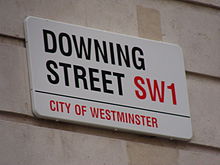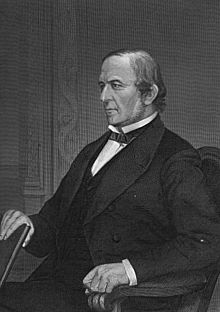Downing Street
![]()
This article or subsequent section is not sufficiently supported by evidence (e.g., anecdotal evidence). Information without sufficient evidence may be removed in the near future. Please help Wikipedia by researching the information and adding good supporting evidence.
Downing Street [ˈdaʊnɪŋstɹiːt] is a street in central London that has been home to the official offices and residences of two of the most important members of British government - the Prime Minister of the United Kingdom and the Chancellor of the Exchequer - for more than two hundred years. The most famous house number in Downing Street is No. 10, which is the official office and residence of the First Lord of the Treasury and therefore also the Prime Minister, as both offices are held by the same person. As a result, "Downing Street" or "Number 10" is often used as an abbreviation for the Prime Minister or his official residence, while "Number 11" is also a designation for the Chancellor of the Exchequer or his official residence.
Downing Street is a side street of Whitehall in central London, just a few steps from the Houses of Parliament, running towards Buckingham Palace. The street was built by Sir George Downing, 1st Baronet (1632-1689), and therefore bears his name. Downing was a soldier and diplomat who served under Oliver Cromwell and King Charles II. In recognition of his service, King Charles II rewarded him with a piece of land adjacent to St. James's Park, over which Downing Street now runs. Both the Prime Minister, the Chancellor of the Exchequer and the leader of the ruling party officially live on the same side of the street. The buildings on the other side were replaced by Foreign Office buildings in the 19th century. In the 1950s and 1960s, consideration was given to demolishing both the Foreign Office and the rest of Downing Street and building something more modern. However, these plans never came to fruition and are now no longer being pursued.

Downing Street

Downing Street, Westminster, London
Houses of Downing Street
No 9 Downing Street has served as the entrance to the Privy Council Office since 2001 and currently houses both the Leader's office and the Department for Exiting the European Union.
No. 10 Downing Street is the official office and residence of the First Lord of the Treasury, whose office has been held by the Prime Minister without exception since 1735.
No. 11 Downing Street has been the residence of the Second Lord of the Treasury since 1828.
No. 12 Downing Street, formerly the official residence of the Leader of the House, currently houses the Prime Minister's Press Office, as well as the Marketing and Communications Office.
Since the existence of these Houses, Ministers have by mutual consent occupied the Houses which best meet their needs. Thus, number 11 is sometimes occupied not by the Chancellor of the Exchequer but by the Cabinet member who has been designated as Deputy Prime Minister; whether or not he takes that title is immaterial. This handling was particularly common in coalition governments. Sometimes ministers used their provided living quarters only for official occasions and lived elsewhere.
During his tenure, which began in 1881, William Gladstone claimed the flats at numbers 10, 11 and 12 for himself and his family. This was appropriate as he was both Chancellor of the Exchequer and Prime Minister at the time.
Following the 1997 House of Commons election, in which the Labour Party took over the government, a change of residence was made between the two incumbents, as the married Tony Blair still had three children living at home, while his colleague Gordon Brown was unmarried when he took over as Chancellor of the Exchequer. Although Number 10 remained the Prime Minister's official residence and official residence, Blair moved his family into the more spacious Number 11, while Brown lived in the smaller Number 10 apartment.
Houses 10, 11 and 12 are connected to each other on several floors by wall openings, so that they are rather to be considered as a building complex. Also, the plots of the three buildings form a single garden at the back without partitions.
The actual private living quarters of the Prime Minister, insofar as they are used for these purposes, are located in the roof slope of the 4th floor, which was extended during a core renovation in the 1960s. Prior to this, the Prime Ministers still used the garden-facing rooms on the 1st floor for residential purposes. Today, these are used for representation and the reception of guests.

William Gladstone moved with his family to numbers 10,11 & 12.
The gates to Downing Street
In 1986, large black steel gates were erected at the entrance to Downing Street to protect then Prime Minister Margaret Thatcher from terrorist attacks by the IRA. Before that, it was possible for the public to use Downing Street as a shortcut to St James's Park. The foundations of the gates were further strengthened in 2003.

The gates to Downing Street
Search within the encyclopedia